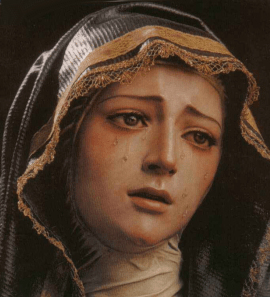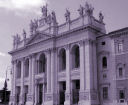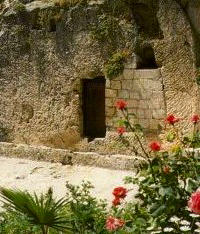» Enjoy our Liturgical Seasons series of e-books!
Responsory from Morning Prayer:
Our Shepherd, the source of living water, has departed. At his passing the sun was darkened, for he who held the first man captive is now taken captive himself. Today our Saviour has shattered the bars and burst the gates of death.
He has torn down the barricades of hell and overthrown the power of Satan. Today our Saviour has shattered the bars and burst the gates of death.
On Holy Saturday, the Church waits at the Lord's tomb, in prayer and fasting, meditating on his Passion and Death and on his Descent into Hell and awaiting his Resurrection. The Church abstains from the Sacrifice of the Mass, with the sacred table left bare, until after the solemn Vigil, that is, the anticipation by night of the Resurrection, when the time comes for paschal joys, the abundance which overflows to occupy fifty days. Holy Communion may only be given on this day as Viaticum. —The Roman Missal, Third Typical Edition
From the Easter Vigil Liturgy of Light:
May the light of Christ rising in glory dispel the darkness of our hearts and minds.
From the Exsultet:
O truly necessary sin of Adam,
destroyed completely by the Death of Christ!
O happy fault that earned so great, so glorious a Redeemer!
O truly blessed night, worthy alone to know the time and hour
when Christ rose from the underworld!
This is the night of which it is written:
The night shall be as bright as day,
dazzling is the night for me, and full of gladness.
“O truly blessed Night," sings the Exsultet of the Easter Vigil, which alone deserved to know the time and the hour when Christ rose from the realm of the dead! (“O vere beata nox, quae sola meruit scire tempus et horam, in qua Christus ab inferis resurrexit!”) But no one was an eyewitness to Christ’s Resurrection and no evangelist describes it. No one can say how it came about physically. Still less was its innermost essence, his passing over to another life, perceptible to the senses. Although the Resurrection was an historical event that could be verified by the sign of the empty tomb and by the reality of the apostles’ encounters with the risen Christ, still it remains at the very heart of the mystery of faith as something that transcends and surpasses history. This is why the risen Christ does not reveal himself to the world, but to his disciples ‘to those who came up with him from Galilee to Jerusalem, who are now his witnesses to the people’” (Acts 13:31; cf. Jn 14:22). (CCC 647).
Holy Saturday
Holy Saturday (from Sabbatum Sanctum, its official liturgical name) is sacred as the day of the Lord's rest; it has been called the "Second Sabbath" after creation. The day is and should be the most calm and quiet day of the entire Church year, a day broken by no liturgical function. Christ lies in the grave, the Church sits near and mourns. After the great battle He is resting in peace, but upon Him we see the scars of intense suffering...The mortal wounds on His Body remain visible...Jesus' enemies are still furious, attempting to obliterate the very memory of the Lord by lies and slander.
 Mary and the disciples are grief-stricken, while the Church must mournfully admit that too many of her children return home from Calvary cold and hard of heart. When Mother Church reflects upon all of this, it seems as if the wounds of her dearly Beloved were again beginning to bleed.
Mary and the disciples are grief-stricken, while the Church must mournfully admit that too many of her children return home from Calvary cold and hard of heart. When Mother Church reflects upon all of this, it seems as if the wounds of her dearly Beloved were again beginning to bleed.
According to tradition, the entire body of the Church is represented in Mary: she is the "credentium collectio universa" (Congregation for Divine Worship, Lettera circolare sulla preparazione e celebrazione delle feste pasquali, 73). Thus, the Blessed Virgin Mary, as she waits near the Lord's tomb, as she is represented in Christian tradition, is an icon of the Virgin Church keeping vigil at the tomb of her Spouse while awaiting the celebration of his resurrection.
The pious exercise of the Ora di Maria is inspired by this intuition of the relationship between the Virgin Mary and the Church: while the body of her Son lays in the tomb and his soul has descended to the dead to announce liberation from the shadow of darkness to his ancestors, the Blessed Virgin Mary, foreshadowing and representing the Church, awaits, in faith, the victorious triumph of her Son over death.
—Directory on Popular Piety and the Liturgy
Although we are still in mourning, there is much preparation during this day to prepare for Easter. Out of the kitchen comes the smells of Easter pastries and bread, the lamb or hams and of course, the Easter eggs.
There are no liturgies celebrated until the Easter Vigil. Some local parish priests bless the food baskets on this day. In Slavic countries there is a blessing of the traditional Easter foods, prepared in baskets: eggs, ham, lamb and sausages, butter and cheeses, horseradish and salt and the Easter breads. The Easter blessings of food owe their origin to the fact that these particular foods, namely, fleshmeat and milk products, including eggs, were forbidden in the Middle Ages during the Lenten fast and abstinence. When the feast of Easter brought the rigorous fast to an end, and these foods were again allowed at table, the people showed their joy and gratitude by first taking the food to church for a blessing. Moreover, they hoped that the Church's blessing on such edibles would prove a remedy for whatever harmful effects the body might have suffered from the long period of self-denial. Today the Easter blessings of food are still held in many churches in the United States, especially in Slavic parishes.
If there is no blessing for the Easter foods in the parish, the father of the family can pray the Blessing over the Easter foods.
The entire celebration of the Easter Vigil must take place during the night, so that it begins after nightfall and ends before daybreak on the Sunday. See further details on the Easter Vigil Liturgy.
Highlights and Things to Do:
- Today we remember Christ in the tomb. It is not Easter yet, so it's not time for celebration. The day is usually spent working on the final preparations for the biggest feast of the Church year. The list of suggested activities is long, but highlights are decorating Easter eggs and attending a special Easter food blessing.
- For families with smaller children, you could create a miniature Easter garden, with a tomb. The figure of the risen Christ will be placed in the garden on Easter morning.
- Another activity for families is creating a paschal candle to use at home. See Family in Feast and Feria, Jennifer Gregory Miller's personal blog for an easy Paschal candle graphic to use to make a candle for home.
- The Directory on Popular Piety discusses some of the various devotions related to Easter, including the Blessing of the Family Table, Annual Blessing of Family Home, the Via Lucis and the Visit to the Mother of the Risen Christ.

Holy Saturday--Easter Vigil of the Sacred Triduum
Station with San Giovanni in Laterano (St. John Lateran):
The Station returns again to St. John Lateran. During the afternoon of Holy Saturday the faithful were summoned here for the final scrutiny of the catechumens. Then, in the evening began the vigil or night of watching which concluded at dawn with the solemn baptisms—-the neophytes, plunged into the baptismal waters and there buried with Christ, were born to the life of grace at the very time when our Savior came forth triumphant from the tomb at dawn on Easter morning.
For more on San Giovanni in Laterano, see:
For further information on the Station Churches, see The Stational Church.








